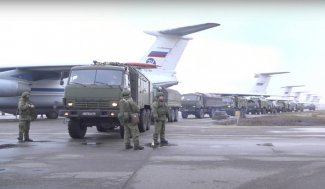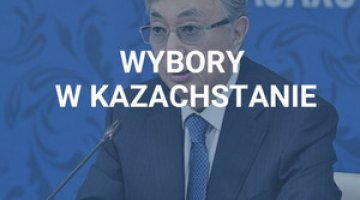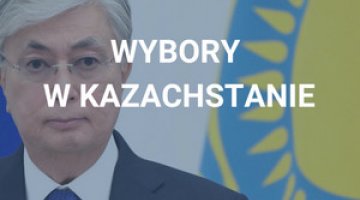Kazakhstan: the CSTO intervenes, the protests pacified

On the night of 5/6 January, at the peak of the social protests taking pace throughout Kazakhstan, the Collective Security Treaty Organisation (CSTO) decided to carry out a so-called anti-terrorist operation at the request of the local government. The first troops arrived in Kazakhstan on 6 January, which significantly strengthened President Kassym-Jomart Tokayev’s domestic position, intimidated the public, and allowed the pacification process to be carried out. Almaty, the main centre of the protests, was effectively pacified, although the work of the security services is still ongoing. It has been difficult to confirm whether the disturbances are continuing in other cities. According to official data (which is undoubtedly incomplete), 164 people have died during the protests, and almost 8000 have been detained. A state of emergency is in force in the country at least until 19 January (including restrictions on information and the internet). The far-reaching settling of scores and reshuffles within the elite and the state apparatus (including a purge within the National Security Committee, NSC) are another important element of the situation.
Commentary
- The protests broke out on 2 January in the western city of Zhanaozen, from where they quickly spread throughout Kazakhstan. The direct cause was the increase in LPG prices, although this was just the spark which ignited the tinderbox of years of dissatisfaction at social conditions and widespread public fatigue at the country’s political stagnation and the government’s abuses. The demonstrations were spontaneous, the political slogans were very general (aimed at representatives of local authorities and Nursultan Nazarbayev, symbolising the political system), and the demonstrators did not organise any formal political representation. On 5 January there were attacks on public buildings; the president’s residence in Almaty, the town hall and media headquarters were burned down, among other locations, and the airport was seized (similar incidents took place in other towns). Clashes with the security forces (some of whom changed sides and joined the protesters) and looting also took place. As the situation spiralled out of control, Tokayev was forced to abandon his previous policy of making concessions to the demonstrators; he had to remove Nazarbayev (from his formal position as head of the Security Council), declare no-holds-barred war against the forces damaging the country (including within the ruling elite), and request assistance from the CSTO.
- According to the narrative which the authorities adopted on 5/6 January, the protests were prepared/taken over by foreign-backed terrorist forces (allegedly numbering 20,000 people), who allegedly had support within the NSC. The terrorist threat was the formal reason for requesting the CSTO’s assistance; for the dismissal of the influential head of the NSC, Karim Masimov, and his deputies (including Nazarbayev’s nephew), and for the charge of treason brought against Masimov. The terrorist threat story is extremely implausible, but remains useful internally and externally, for both the Kazakh government and Russia. The accusations that the NSC inspired the protests cannot be confirmed in any way (although as a body, it was undoubtedly ineffective and disloyal to the president); however, the public protests were clearly aimed at both Tokayev and his political patron Nazarbayev, while also confirming the enormous tension in the state apparatus. The fact remains that Tokayev’s retention of power has been accompanied by a strengthening of his position on the domestic scene, although this is very relative to the importance of the Russian factor. His success in holding on has come at the expense of his domestic rivals; this is evidenced by the purges within the NSC and the government, as well as the announcement of personnel changes in state-owned companies, including the energy firms (who are accused of provoking the protests with the pay rises they introduced) – which will de facto strike at the Nazarbayev family. Nazarbayev himself did not appear in public during the protests, and after them he emphasised his support for the incumbent president; this indicates that he has now been completely marginalised politically, and that Tokayev now dominates the political scene.
- The intervention by CSTO forces remains a turning point in the context of the Kazakhstan crisis. According to official information, over 2000 troops are taking part in the so-called peace or anti-terrorist mission; they are mainly from Russia, but also include soldiers from Belarus, Tajikistan, Kyrgyzstan and Armenia. In accordance with their mandate and the public declarations, they are protecting strategic facilities in Kazakhstan, have not participated in the pacification actions, and should return to their countries after the threat has been dealt with. The intervention was of fundamental political significance: it was an expression of support for Tokayev, offered psychological support to the government forces, and struck at the protesters’ morale. Finally, it meant that the Kazakh military units could be disciplined and freed up to guard the key infrastructure points around the country. In the broader context, this was the first military mission since the CSTO was established (2002); it was also a spectacular manifestation of Russia’s determination and efficiency in mobilising its clients and transferring troops, which will strengthen its position in the post-Soviet area. It should be assumed that the Russian forces will stay in Kazakhstan for a longer period of time and, at least in the short term, will provide important support for Tokayev (until he has taken full control over the situation in the security apparatus).
- At the present stage, it can be assumed that the Kazakh government (and the CSTO) have managed to pacify the protests, although the embers may still smoulder for some time; the feeling of a largely imaginary ‘terrorist’ threat will also be probably maintained for political advantage. Both the deep social problems in the country and the risk that the citizens’ dissatisfaction will become radicalised in the future remain long-term challenges for Kazakhstan. It also seems unlikely that Tokayev’s consolidation of power (by eliminating his opponents and marginalising the Nazarbayev family) will encounter any obstacles; this will bring about a profound reconstruction of the political and personnel system that has operated in the country for the last 30 years.
- The most important consequence of the crisis is the profound weakening of Kazakhstan’s international position. First of all, it has lost its image as a stable country, developing in a sustainable fashion, which effectively steered a course between Russia, China and the West, and enjoyed a potential to stabilise the region which cannot be overestimated. In the current situation – and at least in the short term – the Russian Federation has now become the direct guarantor of the stability of the state and its authorities, and is increasing its influence on Kazakhstan’s strategic institutions and manoeuvres within the ruling elite. At the same time, it has significantly boosted its standing with both its allies/clients in the CSTO and its opponents in the CIS area; with China (confirming Russia’s importance in Central Asia); and the West, whose opportunities to conduct dialogue (or any more ambitious policy) in the context of pacifying the protests have significantly diminished. Kazakhstan has strengthened the Kremlin’s hand in the struggle for Ukraine, and in Russia’s attempt to impose a revision of the post-Cold War international order on the West (the US, NATO).




